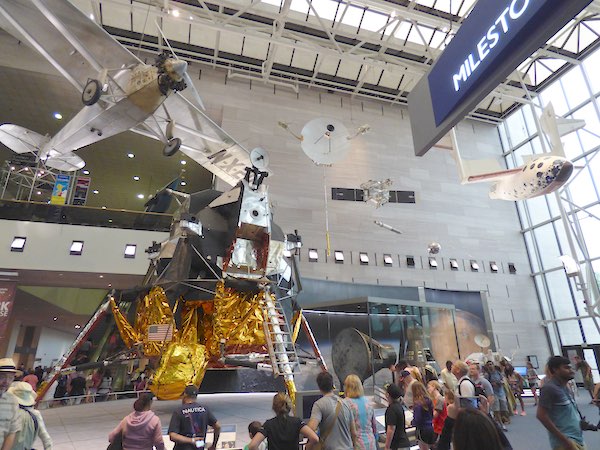Old milestones, new galleryby Jeff Foust
|
| Placing it among other aerospace artifacts, rather than in relative isolation as it once was, actually enhances the Lunar Module. |
The event also marked the “reopening” of the museum’s centerpiece, the Boeing Milestones of Flight Hall. (The hall was never closed during the renovation, but was clearly a work-in-progress to visitors.) The gallery has hosted some of the museum’s most famous aircraft and spacecraft, from Charles Lindbergh’s Spirit of St. Louis airplane to the Apollo 11 command module to SpaceShipOne. The hall has undergone a two-year renovation, moving artifacts and changing how they’re displayed to provide a more contemporary exhibition of historic objects.
One of the most striking changes is the addition of the Apollo Lunar Module. The module, which had previously been displayed at one end of the museum, near the entrance to the food court, is now in the heart of the museum, directly underneath the Spirit of St. Louis. Placing it among other aerospace artifacts, rather than in relative isolation as it once was, actually enhances the spacecraft. It towers over many of the other objects in the hall, and holds its own with the historic aircraft there, including the X-1 and X-15.
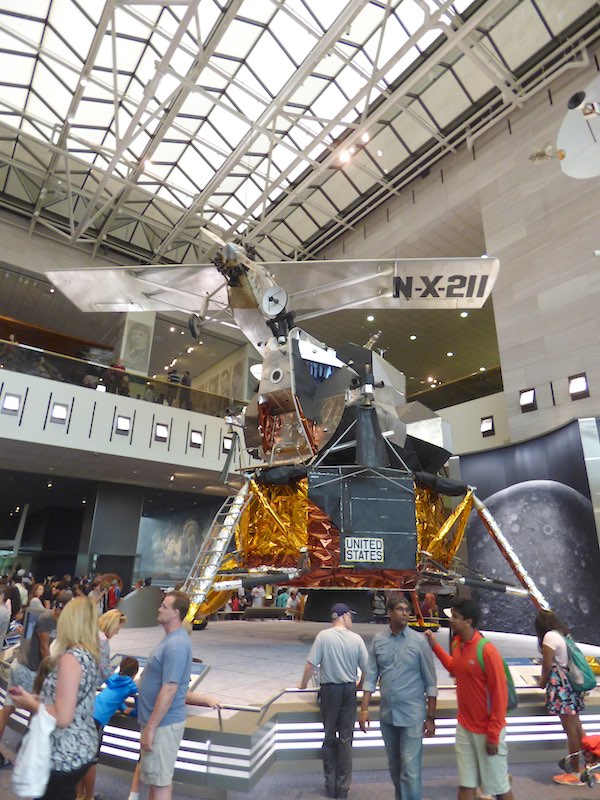 The Spirit of St. Louis appears to soar over the Apollo Lunar Module in the gallery. (credit: J. Foust) |
One wall of the gallery is devoted largely to space artifacts, anchored by the Lunar Module. The Mercury 6 (Friendship 7) capsule flown by John Glenn on the first US crewed orbital flight is on display nearby, alongside the Gemini 4 capsule. The flight model of the Viking Mars lander is now displayed there, with an image of Mars serving as a backdrop. Overhead is SpaceShipOne (with its tail booms extended in the “feathered” position used for reentry), along with models of several spacecraft, including Sputnik and Explorer 1.
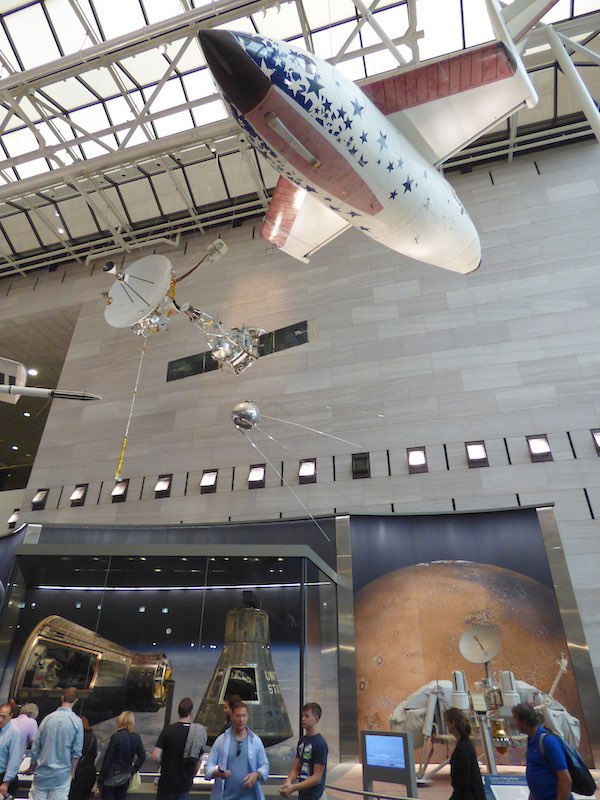 Space items in the gallery include SpaceShipOne (above right), the Viking lander (below right), and Mercury and Gemini spacecraft (left). (credit: J. Foust) |
One of the most popular exhibits, though, is not an aircraft or a spacecraft—well, not a real one, anyway. The model of the starship Enterprise from the original Star Trek series, once consigned to the museum’s gift shop, has now been restored and is in the Milestones hall. It might seem a little odd to place a prop from a science fiction TV show in the same room as the first aircraft to break the sound barrier and the first spacecraft to place an American in orbit, but Star Trek has a special place in American history and has been an inspiration for many to pursue space-related careers.
For crowds at the museum during the July 4 holiday weekend, the model appeared just as interesting, if not more so, than the actual aviation and space artifacts in the hall. And, if they turned around, they got a stronger dose of space history: a display devoted to Sally Ride, the first American woman in space, featuring items from her personal collection donated to the museum. And there was also a Star Trek connection there: a Star Trek communicator pin that she owned.
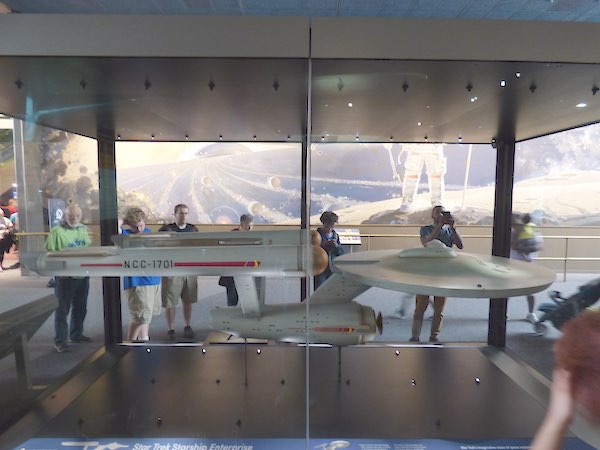 The Enterprise module was a popular attraction in the hall. (credit: J. Foust) |
While the artifacts are, at most, refurbished, there is some new technology in the hall. A giant screen, measuring about 4.9 by 3.6 meters, serves as an “interactive wall” to display information on the museum’s collections. It’s part of a broader effort by the National Air and Space Museum to change their exhibits to ensure they remain relevant to those wedded to their smartphones and the Internet (see “Building the 21st century space museum”, The Space Review, August 3, 2015).
“By experiencing more detailed displays and digital technology, visitors will walk away with a deeper understanding of how spaceflight and aviation have affected their lives,” said museum director Gen. J.R. “Jack” Dailey, in a press release about the renovated gallery. “This approach will guide the plans we have for transforming the building, inside and out, over the next several years.”
| Certainly, placing Apollo 11 in the Space Race gallery makes sense, but the command module looks diminished in its new location, dwarfed by the far larger Skylab and Hubble on either side. |
While some items have been added to the Milestones of Flight Hall, and others moved around, there is one notable subtraction from the gallery. For years, one of the centerpieces of the gallery was the Apollo 11 command module. As the spacecraft that carried the first people to walk on the Moon, the spacecraft is arguably one of the most historic artifacts in its collection, and was in the middle of the gallery for years. But now it’s gone.
Instead, the command module is on display, for now, in the nearby Space Race gallery, along one wall between the backup Skylab space station and the Hubble Space Telescope test article. The location of the spacecraft—which has undergone its own restoration, including 3-D digital modeling—looks temporary, with the module mounted on a wheeled base and surrounded by barriers.
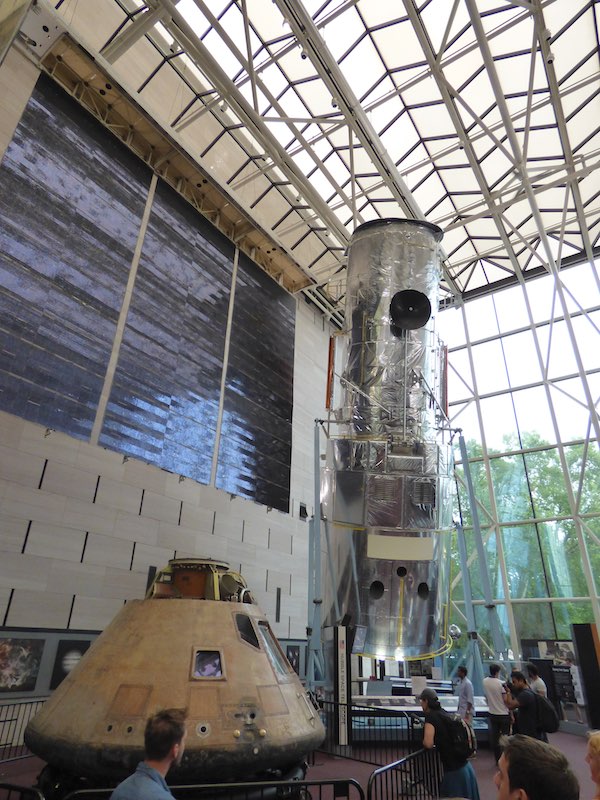 Now located in the Space Race hall, the Apollo 11 command module is dwarfed by the Hubble Space Telescope. (credit: J. Foust) |
Ultimately, the Apollo 11 command module will be at the heart of a new exhibit about lunar exploration, but that may not be ready until the end of the decade. Certainly, placing Apollo 11 in the Space Race gallery makes sense: it was, after all, what won that race between the US and the USSR. But just as the lunar module gained stature by joining the Milestones of Flight gallery, the command module looks diminished in its new location, dwarfed by the far larger Skylab and Hubble on either side.
In some respects, having more high-profile historic artifacts than there’s room for them in a major gallery is a good problem to have. And, hopefully, in the years to come there will new artifacts, representing new achievements in aviation and spaceflight, vying for room there.
